Checkout using your account
Checkout as a new customer
Creating an account has many benefits:
- See order and shipping status
- Track order history
- Check out faster
Hockey Stick Guide
Hockey Stick Buying Guide
At All Rounder Hockey we have put together a comprehensive guide about field hockey sticks. The first thing to consider when choosing a field hockey stick is your playing position. Different positions require different types of sticks. Forwards usually prefer sticks that are lightweight and have a low bow, while defenders often opt for heavier sticks with a higher bow. Midfielders typically choose sticks that offer a good balance between control and power.
In this guide we cover seven key elements when selecting a stick which include
Specifications – An introduction to how a hockey stick is constructed and specialist terminology.
Materials – Here we cover how a stick is constructed from its individual elements.
Length – Hockey sticks can come in varying lengths, this is where we cover the basics.
Weight - Choosing the right weight is crucial, so keep reading.
Head Shape – Different brands produce sticks with different size heads.
Bow – All about the different bow types and technical restrictions.
Price – One of the most important factors when choosing a stick!
Hockey Stick Specifications
Field Hockey is governed by the FIH (International Hockey Federation) who outline the rules and regulations for the sport. Since field hockey first started being played the stick has always kept a traditional shape. This shape has however developed over the years and has been refined by new materials and technologies however what has always stayed consistent is the use of a handle, shaft and head with a curved protrusion at one end.
Please see diagram below.

The Handle: All senior sticks will have a handle of a similar diameter, this is approximately 25-30mm before a grip is applied. The diameter will be proportionally reduced for junior hockey sticks and dependant on brand.
The Head: With the head there are a number of variations such as shapes, concave faces and other technical developments all to aid a certain aspect of the game.
The Shaft: Most hockey sticks a hockey brands stick with a consistent shaft however elements such as stiffness can change and curvature.
FIH Rules of Hockey Sticks correct of 2023.
Diagrams of the stick:
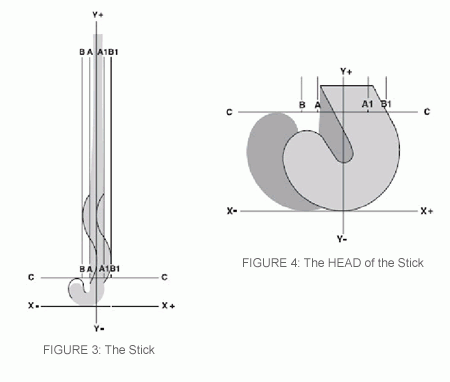

The shape and dimensions of the stick are tested by placing the stick playing side downwards on a flat surface marked with the lines shown in figures 3 and 4. Lines A, A1, B, B1 and Y are parallel and are perpendicular to lines C and X. The dimensions in figures 3 and 4 are:
line A to line A1 51 mm
line A to line B 20 mm
line A1 to line B1 20 mm
line A to line Y 25.5 mm
line C to line X 100 mm
The stick has a traditional shape, consisting of the handle and the head: the stick is positioned in figures 3 and 4 so that the line Y passes through the centre of the top of the handle; the handle of the stick starts at line C and continues in the direction Y+. The base of the head of the stick is positioned touching line X; the head of the stick starts at line X and terminates at line C.
The stick is assessed with any covering, coating or fixing belonging to the stick. In any of the specifications below, the following definitions apply:
“smooth” means without any rough or sharp parts. The surface must be even and regular, free from perceptible projections or indentations and not rough, wrinkled, pitted, grooved or scored. No edge shall have an angle with radius smaller than 3 mm.
“flat” means without any curved, high or hollow parts having a radius smaller than 2 m, transforming smoothly to an edge with a radius not smaller than 3 mm.
“continuous” means all along the defined subject without interruption.
The playing side of the stick is the entire side shown in figures 3 and 4 and the edges of that side. The transition from handle to head must be smooth and continuous without any unevenness or other discontinuity. The head must be a ‘J’ or ‘U’ shape the upturned or open end of which is limited by the line C. The head is not limited between lines C and X in the direction X- or X+.
The head must be flat on the left hand side only (the side which is to the player’s left when the stick is held with the open end of the head pointing directly away from the player’s front, ie the side shown in the diagrams). A single convex or concave deviation with a smooth continuous profile and of maximum 4 mm at any point is permitted across the otherwise flat playing side of the head of the stick and any continuation of it along the handle.
Deviation is tested by placing a straight edge of length 53mm across the stick at any point along the playing side and using a standard pointed depth gauge; the device used to measure bow or rake and shown in figure 6 can also be used for this purpose. The depth of concave curvature below the straight edge must not exceed 4 mm. Other indentations or grooves are not permitted on the playing side of the stick.
The flat playing side of the head of the stick and any continuation of it along the handle must be smooth.
A twist or twists along the flat playing side of the stick from the head and any continuation of it along the handle are not permitted; ie the intersection of the plane comprising the flat playing side of the stick with any plane comprising all or part of the flat side of the handle must remain parallel to line C-C.
It is permitted for the handle to be bent or curved to protrude beyond the line A once only to the limiting line B at maximum or but not also to be bent or curved to protrude beyond the line A1 once only to the limiting line B1 at maximum.
Any curvature along the length of the stick (the bow or rake) must have a continuous smooth profile along the whole length, must occur along the playing side or the back of the stick but not both and is limited to a depth of 25 mm. The point of maximum bow must not be closer to the base of the head (line X in figure 3) than 200 mm. Multiple curves are not permitted. The stick is laid playing side downwards on a flat surface in its natural resting position as shown in figure 5. The device shown in figure 6 is used to measure the bow or rake and is placed with its base on the testing surface. The 25mm high end of the device must not pass freely more than 8mm under the stick at any point; ie this end of the device must not pass freely under the stick to the extent that the edge of the stick touches the remaining part of the device.
The edges and the non-playing side (back) of the stick must be rounded and must have a continuous smooth profile. Flat sections along the edges or back of the stick are not permitted. Smooth and shallow undulations or indentations on the back of the handle are permitted to a maximum depth of 4 mm. No undulations or indentations are permitted on the back of the head of the stick.
Inclusive of any additional coverings used, the stick must pass through a ring with an interior diameter of 51 mm.
The total weight of the stick must not exceed 737 grams. The length of the stick as measured from the top of the handle to the bottom of the head of the stick (line X in Figure 3) shall not be more than 105 cm.
Ball speed must not be greater than 98 % of stick head speed under test conditions. Ball speed is determined over a series of 5 tests at a stick speed of 80 km/hour in the simulator of an FIH approved laboratory. Ball speed is calculated from the time the ball passes two measuring points and is expressed as a ratio to the specified stick speed. FIH approved hockey balls are used. The test is carried out at prevailing laboratory conditions with a temperature of approximately 20°C and relative humidity of approximately 50 %.
The entire stick must be smooth. Any stick which poses a potential risk for play is prohibited.
The stick and possible additions may be made of or contain any material other than metal or metallic components provided it is fit for the purpose of playing hockey and is not hazardous.
The application of tapes and resins is permitted provided that they are not hazardous and that the stick conforms to the specifications.
Full information on the latest rules can be found here: http://www.fih.ch/inside-fih/our-official-documents/rules-of-hockey/
Hockey Sticks Materials
Originally hockey sticks were made our of Mulberry wood however as the game has advanced over the years and both technology and materials have improved hockey sticks have changed. The introduction of playing on both sand and water based artificial pitches has meant new materials have been needed in the manufacture of hockey sticks. Wood sticks are the most traditional, but they are heavier and less responsive than modern sticks.
In the 90s aluminium shafted sticks were introduced to the game. These hockey sticks significantly increased hitting power however injuries occurred from these sticks breaking which led to the FIH banning the use of metallic components.
This made brands turn to additional materials such as fibreglass, carbon fibre and Kevlar which had become cheaper to produce forming the now used composite hockey stick.
 '
'
Fibreglass: Cheap and easy to control, fibreglass is made from fine strands of glass and is often woven together and combined with a resin to increase strength and stiffness. Most cheaper priced and junior sticks are made from this material.
Kevlar/Aramid: This fibrous material often used in built proof vests and body armour is very strong yet flexible. Kevlar or Aramid as it is generically called, is used to increase the strength of the stick to a level above that of fibreglass. This material is often used throughout the core of a shaft and on the head of a stick to improve durability.
Aerocore: New from Grays is the AC Collection, which features Aerospace-grade foam is used within the core, providing exceptional feel & complete control of weight distribution.
Graphene: The Grays GR Range features sticks made from graphene which is exceptionally strong and light
Carbon Fibre: Very light strands of carbon are often woven into sheets or strips which can be then moulded into hockey sticks. Carbon Fibre is very stiff and strong and often makes up the entire higher level hockey stick. Carbon Fibre is the material used to create the stiffness in hockey sticks which in turn lead to the greatest amount of power being transferred from the stick to the ball. In brief, the more Carbon Fibre in a stick, the stiffer it is. The weakness of carbon fibre is its low resistance to impact or brittleness, which causes it break. As a result Carbon Fibre is often combined with Kevlar/Aramid in order to take advantage of its strength yet prevent breakage.
A composite hockey stick is manufactured by a number of woven fibres containing the materials listed above. These fibres are placed into a mould where the stick is baked often in batches before being cooled so that they can be branded with designs. The cross section highlighted shoes a twin channel shaft of a hockey stick which helps to provide a strength to weight ratio. Composite sticks are the most popular because they offer a good balance of power, control, and flexibility.
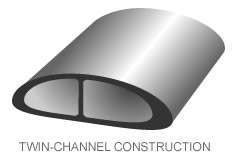
Composite sticks have a greater power to weight ratio than other material hockey sticks such as wood i.e. strength and stiffness can be maintained by a lighter weight composite stick.
The heads of composite hockey sticks are designed to create a larger and more forgiving sweet spot for maximum hitting power.
The manufacturing process leads to composite sticks being much more consistent in their weight, stiffness and power, so if you've used one stick you can be fairly confident another hockey stick of the same specification will feel and perform to the same level.
Hockey Sticks Length
Hockey sticks are produced in a variety of sizes from junior hockey sticks through to senior with the largest normally being 38.5 inches in length. The average hockey stick size for adults is 36.5 inches. Choose the right length of your stick is important as the right length depends on your height and playing style. As a general rule, your stick should be as tall as your hip bone when you’re standing with your shoes on.
Ultimately the choice is down to the player on what feels most comfortable however choosing the wrong size can impact upon your playing ability. Some players decide to go with a longer stick so that they do not have to lean down as far! Generally the below table applies:
|
Player Height |
Stick Length |
|
Below 4 ft |
30 inch |
|
4ft - 4ft 7in |
32 inch |
|
4ft 7in - 5ft |
34 inch |
|
5ft - 5ft 4in |
36 inch |
|
5ft 4in - 6ft 2in |
36.5 inch |
|
6ft 2in - 6ft 5in |
37.5 inch |
|
Above 6ft 5in |
38 inch |
Hockey Sticks Weight
Field hockey sticks can be produced in a range of different weights: Heavy, Medium, Light however composite sticks can also be produced in Super Light. The FIH set the maximum weight as 737g although as the composite sticks are stronger than wood and are significantly lighter most people play with a light stick and there are becoming less medium weights on the market.
The weight you choose can affect your game. A lighter stick is easier to manoeuvre and better for dribbling, while a heavier stick can provide more power and control.
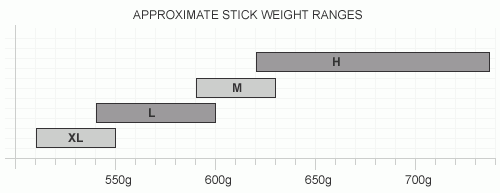
Hockey Sticks Head Shape
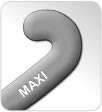 With field hockey being played on artificial surfaces rather than grass, manufacturers have developed a number of different head shapes to provide better control and for shooting on the reverse stick side.
With field hockey being played on artificial surfaces rather than grass, manufacturers have developed a number of different head shapes to provide better control and for shooting on the reverse stick side.
Maxi Head:
Developed in the 90s for composite sticks, the maxi provided more control on the reverse playing side. The increased surface area gave a greater sweet spot for increasing power. The maxi head is used in over 90% of sticks in the market.
As the Maxi head is so dominant, manufacturers have turned to developing additional features to aid players such as larger reverse areas, concave head profiles for drag flicking and further bow development.
TK’s CWT (Control Wing Technology) has created an indented or concave head running from the toe to the top of the head which is normally available with a low bow profile stick. This development is aimed at players who like to drag flick as the ball can flow through the channel for greater accuracy and speed.
TK CWT 2 / Kookaburra Skill Zone technologies use the benefits of the concave design but on a reduced amount of the stick so the normal player can have greater ball control and a more consistent rebound/stopping ability while playing.
Grays Scoop Profile uses a 4mm indentation around the head for greater control on the ball however it leaves a flat central playing surface. On the downside hitting from an upright position with poor technique can lead is a loss of control.
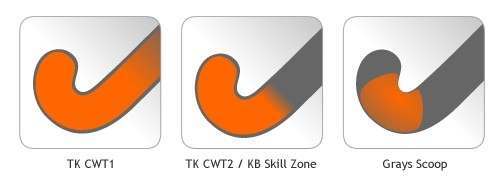
Hockey Sticks Bow
The bow shape of a field hockey stick refers to the degree of curvature in the shaft. A lower bow shape offers better control and is ideal for technical players, while a higher bow shape provides more power and is better for players who like to flick and drag the ball. The amount of bow can be measured by placing the hockey stick face down on a flat surface and measuring the maximum distance between the surface and the stick.
As with the weight of a hockey stick there are limitations to the bow with the FIH setting the maximum level of bow to be 25mm. This rule was brought into place to help standardise sticks and reduce levels of danger while playing as sticks with significant bows can produce drag flick speeds of up to 90mph!
The positioning of a bow can significantly influence the playing style of a hockey player with generally two different types Mid and Low bows.
Low Bows help to generate a slingshot effect so are perfect for penalty corner and drag flick specialists however due to the increased bow, hitting and passing can be influenced due to where the ball comes into contact on the hockey stick.
The Grays stick range of low bows include the Probow - great for flicks and tricks! Plus it's straight rear profile allows consistent execution of reverse stick passes and shots. Plus the Jumbow which has a traditional low bow blade profile designed for maximum power, plus drag flicking and aerials
Grays mid bow range contains:
Dynabow - designed for all round gameplay perfromance, featuring a sweeping curve with slim mid-section and quick hand movements.
Midbow - has an enhanced Low Backhand Zone provides greater consistency when reverse hitting. It is continuously contoured along the length of the blade.
Ultrabow - the straighest profile Grays offer, ideal for learning and executing the core skills of the game.
Hockey Sticks Price
The price of a hockey stick is generally down to the cost of production and materials it is made from. Brands will normally produce a range of sticks with varying percentage amounts of the different materials with the most expensive being close to 100% carbon based and cheapest being made from fibreglass. Our top end sticks are over £300 as used by international players, but we also stock affordable entry-level sticks instore and online.
Some manufacturers are not always happy to reveal the composition of a stick to avoid like for like comparisons with other brands however we endeavour to provide as much information as we are given.
So if you have made up your mind then view our full range of hockey sticks or choose by brand:



